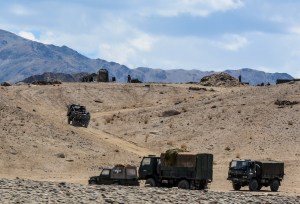The last week has been tense for India and China, the two largest standing armies in the world.
For the first time in 45 years, shots were exchanged in a “provocative” manner at the de facto border, known as the Line of Actual Control (LAC).
Videos by VICE
This is the latest in months-long border conflict that involves deteriorating trust, border transgressions and violence.
In the last 48 hours, the People’s Liberation Army (PLA), the Chinese army, released images of jet bombers and military transport aircraft at an undisclosed airfield near the border. A news report stated that the country is preparing elite special forces as part of its military build-up with India.
India, too, displayed military flex when the Special Frontier Force (SFF), a covert outfit that recruits exiled Tibetans, was reported to be involved in an operation from August 29 to 31, in the south bank of Pangong Lake, a disputed territory. Deployment of Indian soldiers in large numbers was also reported in the last 48 hours.

This year marks one of the lowest points at the LAC, which forms parts of China’s border with India, experts told VICE News. The two nuclear powers have sparred at the border in the past, and there have been disengagements and de-escalation talks, too.
It started in May, when fistfights and stone-pelting were reported between Indian and Chinese soldiers from the Himalayan region of Pangong Tso lake in Ladakh.
“The developments this year suggests a complete collapse in the architecture that the two sides had built up over more than two decades to maintain peace along the disputed border,” Ankit Panda, Stanton senior fellow at the Nuclear Policy Program at Carnegie Endowment for International Peace, told VICE News.
There are also fears that the present situation could even lead to an unintentional war between the two countries. “Of all the conflicts Beijing has with its neighbours, the one with India is most likely to blow up,” Isaac Stone Fish, a senior fellow at the Asia Society’s Center on US-China Relations, told VICE News. “It could even spark a war.”
Here’s all you need to know about the conflict, and why it has the world worried.
China and India Have a History of Sparring
After China invaded Tibet in 1950, an attempt with India to formalise their borders turned into a dispute. The seemingly inhospitable landscape of the border—with its cold desert, freezing temperatures and arid vegetation—has seen multiple skirmishes since.
In 1962, the two countries entered into a war. China won conclusively. The LAC was effectively marked and patrolled by both armies. The rules of engagement signed by the two countries made sure that the armies do not open fire, among others acts of conflict, to maintain peace. However, border transgressions and scuffles between soldiers are common.
It’s Not Always Been Bad, But It’s Been Unpredictable
The two countries have had bilateral relationships in the past. From 1954 until the 1962 war, “Hindi Chini bhai bhai (India and China are brothers)” marked diplomatic and trade brotherhood between the two.

In 2019, Indian Prime Minister Narendra Modi hosted Chinese President Xi Jinping in the southern Indian city of Mamallapuram, over an informal meeting. This was despite a major stand-off between Chinese and Indian soldiers in 2017.
Experts say that even though China and India have different perceptions of the LAC, the two manage to de-escalate tensions without violence. Things are always unpredictable, however. “The norms of behaviour that governed how Indian and Chinese troops interacted along the LAC were never truly ironclad, even if they succeeded in preventing any killings between 1975 and June 15, 2020,” said Panda.
The Nature of the Conflict Changed This Year
The last few months, experts said, broke a substantial amount of strategic trust between the two countries.
Manoj Kewalramani, a fellow of China studies at The Takshashila Institution, an Indian think tank, told VICE News that the Galwan Valley face-off marks a watershed moment in the ongoing conflict. “I don’t see the present Indian government going back to business as usual with China. Even the next ones will find it difficult to do that,” he said.
In June, a deadly clash between soldiers of Indian and Chinese armies led to killings of 20 Indian soldiers in Ladakh’s Galwan Valley. This was the first casualty since 1975. China did not release information about its casualties or injuries.
Panda agrees that unlike previous successful de-escalations, this time is different. “As the winter approaches, neither side is backing down and is seeking to maximise leverage with hopes that this may yield results in diplomacy,” he said. “Diplomacy itself appears to be logjammed as neither side wants to make the first move to step back.”
How China Views the Dispute
State media narratives consistently drive the countries’ positions. In response to this week’s skirmish, The Global Times, the Chinese state media platform, published an opinion piece asking whether the Indian troops firing shots could spark “a new era of bloodshed” at the border.
“You have crossed the line! Your nationalist public opinion has crossed the line! Your policy toward China has crossed the line! You are over-confidently provoking the PLA and Chinese people—this is like doing a handstand on the edge of a cliff!” said the piece.
Kewalramani said that conflicts like border disputes are best managed away from the public gaze. “Official communication from both sides has been about setting the narrative about the conflict among their populations. The aim has been to characterise the other side as the aggressor,” he said.
“The PLA’s display of strength via videos or photos in the Chinese media also plays out as psychological operations and public opinion warfare. The objective is to demoralise the other side.”
The LAC Is Changing Fast
Experts say that the reports of China and India amping up their military presence is changing the nature of the LAC.
Arzan Tarapore, a South Asia research scholar at the Walter H Shorenstein Asia-Pacific Research Center at Stanford University, told VICE News that “normal patrolling practices” might not resume anytime soon at the border.
“There is no longer any trust that the other side will abide by the multiple agreements that had regulated the border until this crisis,” said Tarapore.
Along with heavy militarisation, there are news reports of China moving into the Indian territory for years.
Is it Downhill for India-China Relationship or Is There Hope?
This year’s events, especially the Galwan Valley face-off, led to a ban on Chinese-origin apps by the government of India, and an unofficial boycott of Chinese products. This, despite the fact that both countries are economically interdependent.
“Incidents on the border will affect the whole gamut of relationships including trade and investment,” Sanjeev Kumar, a research fellow at the Indian Council of World Affairs in New Delhi, told VICE News.
Experts said that the two countries need to address structural challenges rather than engaging in “summitry” on paper over the dispute with “pleasantries and window-dressing” by the countries’ leaders.
Tarapore said that the dispute between the two is more than just the border. “The structural reality of the relationship is that both China and India are expanding their national power, and with it their national security interests, and these interests are increasingly likely to collide,” he said. “We see it today on the unsettled border. Tomorrow we may see it in other areas, like the Indian Ocean region.”
Kumar added that the role of diplomacy should not be underestimated.
On September 11, Wang Yi, the Chinese foreign minister, and Indian external affairs minister, S Jaishankar met in Moscow, Russia, to defuse the boiling border tensions. During the two-and-a-half-hour meeting, the Yi and Jaishankar discussed how “not to allow differences to become disputes.”
“Unlike earlier occasions, when [China and India] issued separate statements accusing each other, this time, both sides were able to issue a joint statement this time,” said Kumar.
China-India Border Dispute Affects Others, Too
The India-China relations also impacts their relationship with other neighbouring countries. “At present, everyone in the region is waiting and watching. All the neighbours have their own interests and they don’t particularly mind China and India competing,” said Kewalramani.
Stone Fish said that China’s actions are worrying for countries in the region such as Vietnam, those in the South China Sea and, to a degree, Japan.
“They see what Beijing is doing with India, and they are concerned they could be next,” he said.
Follow Pallavi Pundir on Twitter.










